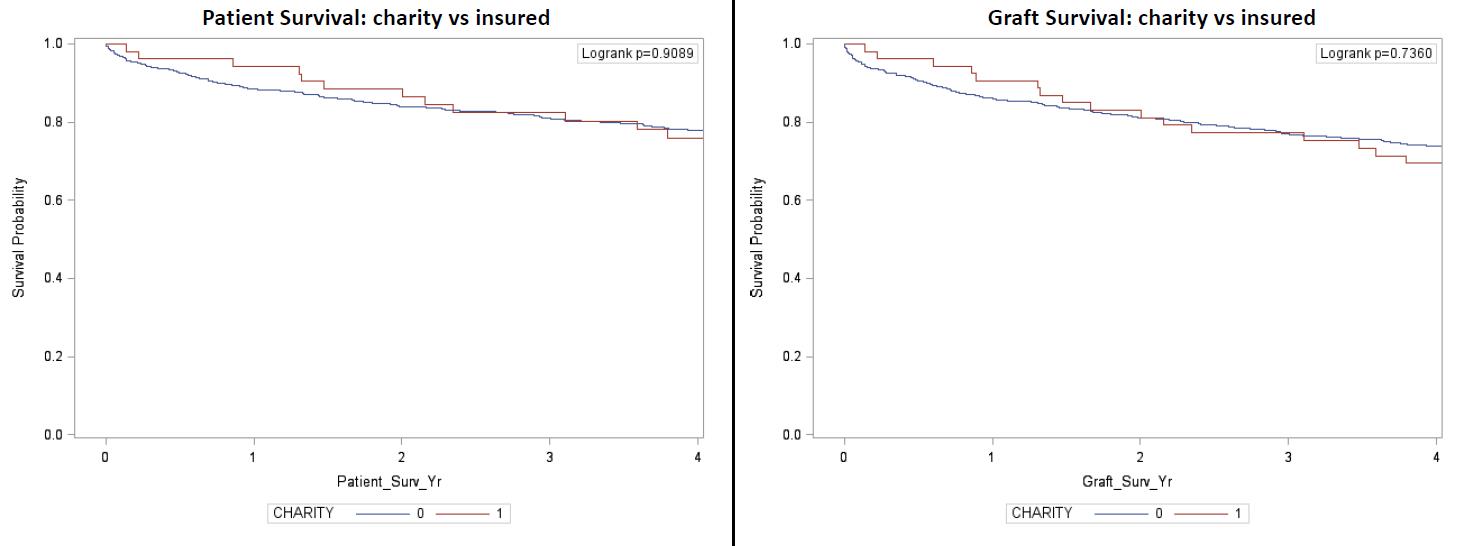Excellent Outcomes in Liver Transplantation under Charity Care: An Opportunity to Mitigate Socio-Economic Disparities in Access to Transplantation
1Department of Surgery, Division of Transplant and Hepatobiliary Surgery, Rutgers New Jersey Medical School, Newark, NJ, 2Department of Medicine, Division of Hepatology, Rutgers New Jersey Medical School, Newark, NJ
Meeting: 2019 American Transplant Congress
Abstract number: D183
Keywords: Allocation, Graft survival, Liver transplantation, Outcome
Session Information
Session Name: Poster Session D: Non-Organ Specific: Disparities to Outcome and Access to Healthcare
Session Type: Poster Session
Date: Tuesday, June 4, 2019
Session Time: 6:00pm-7:00pm
 Presentation Time: 6:00pm-7:00pm
Presentation Time: 6:00pm-7:00pm
Location: Hall C & D
*Purpose: Lack of health insurance is a major barrier in the access to health care even in the case of life-threatening conditions like end-stage liver disease. As a part of University Hospital (UH) mission, uninsured New Jersey residents selected after a complete psychosocial and economic evaluation are eligible for financial coverage of their liver transplant through charity care covered by the hospital. The aim of this study is to assess long-term outcomes in liver transplantation performed in uninsured patients under charity care.
*Methods: This study included all consecutive patients who underwent liver transplant at University Hospital (Newark, NJ) from 2002 to 2015. Kaplan-Meier curves and Log-Rank test were used to compare survival rates, Cox proportional hazards regression was applied for the adjusted analysis with confounding variables.
*Results: Between 2002 and 2015, 850 patients underwent liver transplant, of which 496 had private insurance, 192 Medicare, 109 Medicaid, while 53 patients were uninsured and their transplant costs were covered under charity care. Patients under charity care were slightly younger than insured patients (median age: 49 vs 55 years, p<0.01) while there were no differences in gender, cause of liver disease, MELD score, disease severity, or donor age. Both insured and charity care patients presented similar median duration of post-transplant hospital stay (9 vs 10 days, p=0.20) and readmission rates (33.1% vs 33.3% at 6 months, p=NS). There was no difference in patient and graft survival between insured patients and charity care patients (figure). In the multivariate Cox regression model, charity care was not associated with worse graft survival (HR:1.00, 95%CI:0.64-1.56, p=0.99).
*Conclusions: Liver transplantation performed under charity care is associated with non-inferior outcomes when compared with insured patients and may contribute to mitigate socio-economic disparities in the access to liver transplantation.
To cite this abstract in AMA style:
Paterno F, Rosado J, Olivo R, Gavzy S, Brown L, Wilson D, Koneru B, Pyrsopoulos N, Guarrera JV. Excellent Outcomes in Liver Transplantation under Charity Care: An Opportunity to Mitigate Socio-Economic Disparities in Access to Transplantation [abstract]. Am J Transplant. 2019; 19 (suppl 3). https://atcmeetingabstracts.com/abstract/excellent-outcomes-in-liver-transplantation-under-charity-care-an-opportunity-to-mitigate-socio-economic-disparities-in-access-to-transplantation/. Accessed December 30, 2025.« Back to 2019 American Transplant Congress

